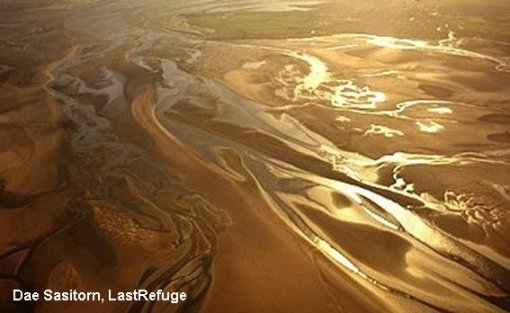By sea and rivers, Scottish border
Fast-flowing streams in highlands like those of northern England & southern Scotland can move weathered rock grains, pebbles, and even large boulders for short distances, after heavy rain.
During their long journey down river, the rock fragments may settle out and get picked up again many times, and become gradually more worn-down and smaller in size each time they are moved on.
When a river meets the sea, then its flow almost ceases. Much of its sediment is deposited rapidly, choking its own channel so that it has to cut new ones. This results in a braided pattern, as you can see here. Waves and tidal currents often re-erode and deposit the sand, piling up sandbanks or bars, whilst keeping much of the finer mud in suspension. This mud is deposited in calmer waters to form mudflats sheltered by sand bars, or carried offshore to slowly settle out in deep water.
During their long journey down river, the rock fragments may settle out and get picked up again many times, and become gradually more worn-down and smaller in size each time they are moved on.
When a river meets the sea, then its flow almost ceases. Much of its sediment is deposited rapidly, choking its own channel so that it has to cut new ones. This results in a braided pattern, as you can see here. Waves and tidal currents often re-erode and deposit the sand, piling up sandbanks or bars, whilst keeping much of the finer mud in suspension. This mud is deposited in calmer waters to form mudflats sheltered by sand bars, or carried offshore to slowly settle out in deep water.
Solway estuary, Scottish border

Dae Sasitorn/www.lastrefuge.co.uk

